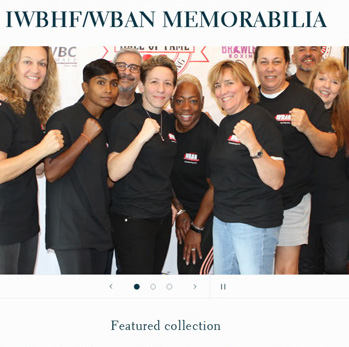The sport of Women's boxing has
accumulated a large litany of "not enoughs:" Not enough "face-off"
bouts between the top fighters in the sport; not enough "live"
television coverage; not enough serious consideration given to the
sport becoming part of the Olympics; not enough knowledgeable
mainstream media coverage beyond publicity for a semi-realistic
movie and newsprint for a few "bold face" boxers, more renowned for
their heritage or their outside-the-ring photo "spreads."; not
enough "championship" bouts worthy of the "title." But, most,
notably, the sport of Women's boxing has "not enough" women. No, not
women in the ring, women outside the ring, in a position of
leadership, those women fully capable of guiding the sport of
Women's boxing.
Think about it for a moment: where was the Women's Tennis
Association (WTA) in the days before Billy Jean King seized that
sport by the throat and, literally, forced it into national
recognition, culminating in, among other things, an equal prize
money structure at major tournaments? Where was the Ladies
Professional Golf Association (LPGA) before Louise Suggs and Patty
Berg persuaded Dinah Shore to host the Nabisco Open and that
tournament became the first women's golf event to have all four
rounds covered on national TV? The answer is that women in tennis
and golf, the two leading professional women's sports in the
country, were in exactly the same place that women boxers are today,
under-publicized, under-organized, under-paid and under-appreciated
for their skills.
In tennis and golf, women, leaders like King, Suggs and Berg, made
the difference, a huge difference in the development of their sport.
They assumed leadership and a lot of the barriers that had
previously blocked the sport's progress started going down. They
went down because King and Suggs and Berg, figuratively, kicked them
down. It wasn't easy, change never is. It wasn't quick and simple,
nothing worthwhile ever is. And it certainly didn't occur overnight
or over a year or two years. It happened gradually. But, eventually,
on the sports pages in this country, names such as Chris Evert and
Martina Navratilova and Nancy Lopez started showing up on a regular
basis. With that in mind, contrast tennis and golf with boxing.
Women continue in the leadership of female tennis and golf, while,
conspicuously, there are no women at the front of female boxing. Men
run boxing, they run men's boxing, they run women's boxing. And,
it's fair to ask, how's that been working, so far?
A "combat sport," contested in cages, that was, at one time, barred
in the majority of states in this country, now threatens to surpass
boxing in the national consciousness. A "sport" that has taken on
some of the superficial trappings of professional wrestling and
combined it with the type of realistic mayhem that usually results
when a bartender tells two "patrons" to "take it outside," now
appears on the cover of the nation's leading sports magazine. Boxing
is in decline and the sport of Women's boxing, still in very much of
a complementary position, is suffering because of that decline. The
time has never been more opportune for a change in the direction of
the sport of Women's boxing. And that change should come, as it did
for tennis and golf, with the emergence of women moving to the
forefront of the sport's leadership. Men guiding the sport of
Women's boxing is, in a minor way, akin to a white man leading the
NAACP; that man may be well meaning and have the best interests of
the organization at heart, but he lacks the inherent empathy, the
understanding of the people and their aspirations that a person of
color would bring to the leadership.
Am I suggesting some sort of exclusive, women-only leadership
council? Of course not! There are, and will continue to be, many
effective advocates, supporters and implementers of the sport of
Women's boxing who have played an integral part in it's development:
promoters and managers currently in locations as diverse as Detroit,
New Mexico and Lemoore, a longtime promoter of the sport and a
broadcast executive who conceived, drove and mounted a valiant
effort to position Women's boxing in a favorable television
environment, a promoter who was instrumental in putting the first
all-Women's boxing card on "live" television and who, recently, was
a key player in another three-bout female card broadcast on Fox
Sports. And, when I last looked, Jimmy Mallo, Lenny Fresquez,
Christian Printup, Arnie Rosenthal and Rick Kulis are all firmly
positioned on the male side of the gender divide. These men, and
some like them, will continue to play the integral role in the sport
of Women's boxing that they already have.
What I'm suggesting is that some women, already positioned within
the structure of the sport, move to the forefront and assume a move
proactive role in the direction of Women's boxing. Here's what I not
suggesting: an infusion of those bold faced names, those women more
interested in self-absorbing publicity for themselves rather than
for the sport; what I'm not suggesting is those women who are
unwilling or unable to do the tough work of kicking down the doors
of TV networks that refuse to recognize the skill of top women
boxers and the equally tough job of dealing with promoters who still
think female boxers belong on the bottom of a fight card and at the
bottom of the pay scale. Those "bold faces" know who they are,
everyone in the sport knows who they are, they're the ones who show
up only when the "red light" of TV is on, and, are gone when the
hard work starts.
The women I'm thinking about are already deeply involved in doing
the tough work in the sport of Women's boxing. It's the ex-boxer who
supplies news and promotes female boxing and boxers on the "site of
record" of the sport; it's the boxer who is winding up a singular
career in the ring that has coupled her, now and forever, with the
sport of Women's boxing; it's two women who have already made
inroads in the sport as part of separate state boxing commissions;
it's the woman who has succeeded, as the first female, to the board
of the major boxing sanctioning body; it's the woman and an educator
of high school students, who competes in the professional ring for
many reasons, all of them exactly right, the love of the sport, the
joy of competition and who, with every bout similarly educates
boxing fans on the meaning of professionalism. Sue Fox, Christy
Martin, Deirdre Gogarty, Trina Ortegon, Jill Diamond and Dee
Hamaguchi are examples of women currently making positive
contributions to their sport and women who have the potential to do
what King and Suggs and Berg did for theirs.
Do I have a detailed plan? I do not. Smarter people than I, in the
sport, will come up with that. What I do know is that Women's boxing
needs help, it needs a lot of help and it's not going to get it from
a "business as usual" approach. That much we know from history.
Here's one more thing we know: the athletes in the sport are women,
up and down the talent scale, and in the final analysis, the
athletes, those who climb into the ring, are the ones who will have
to put positive change into effect. They are the ones who have to
step up and take the tough bouts, the bouts that will lead to more
television coverage. The fighters are the ones who will have to
agree to travel to distant venues to take those tough fights. The
fighters will make the difference because, once the bell rings,
they're the only ones in the sport who count. And they're all women.
Are they more likely to listen to another woman, one "who's been
there, done that," a woman who talks to them, not at them, and does
so without a hint of patronizing? My bet is the fighters will not
only listen, they'll pay attention because of the realization that
they're listening to someone who they know is speaking form
real-life experience. And that's probably a sea change from a lot of
the talk female fighters are hearing today. There are many problems
in the sport of Women's boxing, too many "not enoughs" and one of
the biggest is "not enough" knowledgeable, straight talking women
leaders.
What's the first step? The top women in the sport, those mentioned
and probably several others, start communicating with each other,
start accumulating their knowledge and experience in the sport. They
begin by talking about the current state of Women's boxing and the
future direction the sport should take. And then, these women, these
leaders, should begin pushing the sport in that direction; pushing
the promoters, pushing the media, pushing the managers, pushing the
fighters, pushing whomever necessary to get the sport of Women's
boxing out of it's current state of "not enoughs" and moving towards
a level of success that the right mix of leadership can achieve.
#
# #
#

For Online IWBHF Tickets for
Next Event!
Check Our Next Annual International
Women's Boxing Hall of Fame Event that we have to celebrate hour IWBHF
Inductees and Special Award Recipients!
Next Event, Go Here!

Our Online
WBAN/IWBHF Online Store
Proceeds from the Online Store is to
continue our mission to support the INTERNATIONAL WOMEN'S BOXING HALL OF
FAME. The Official collection includes IWBHF and WBAN Merchandise and
Memorabilia from the WBAN Boxing Collection. We will continue to list
items from the collection and merchandise.
